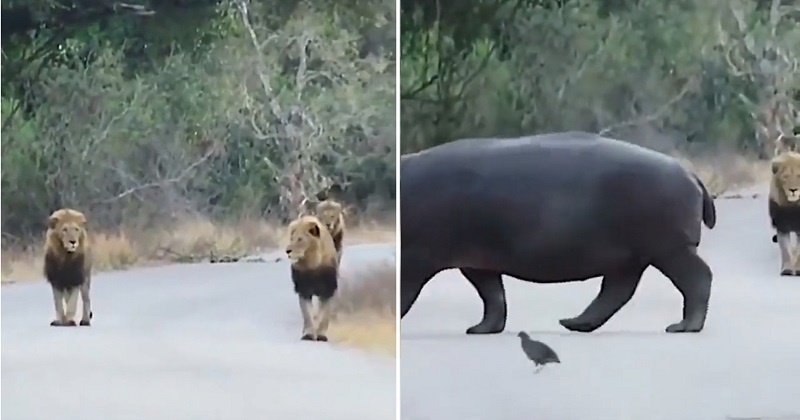
शेर का नाम सुनते ही डर लगने लगता है, चाहे वो इंसान हो या जानवर. शेर बहुत खतरनाक होते हैं इसलिए इनका नाम सुनकर ही लोग कांप उठते हैं। क्योंकि एक बार अगर कोई शेर के सामने आ जाए तो उसका वहां से भागना नामुमकिन होता है. लेकिन, क्या आपने कभी जंगल के सबसे खतरनाक जानवर के बारे में सुना या देखा है, जिसके सामने हर कोई हार जाता है और जिससे जंगल का हर जानवर डरता है। अगर नहीं देखा है तो सोशल मीडिया पर वायरल हो रहे इस वीडियो को देख लीजिए जो कुछ ऐसा ही दिखा रहा है, आपको यकीन नहीं होगा.
Even the king respects the right of passage…
— Susanta Nanda (@susantananda3) March 1, 2022
Lion stopping to give way to the bird.
🎥Animales y bichitos pic.twitter.com/ZNiH5xI4hj
वायरल हो रहे इस वीडियो में आप देख सकते हैं कि सड़क पर सामने से 3 शेर आ रहे हैं और तभी बगल से एक गैंडा और एक पक्षी सड़क पार करते नजर आ रहे हैं. जैसे ही पक्षी सड़क पार करना शुरू करता है, तीनों शेर वहीं रुक जाते हैं जब तक कि पक्षी सड़क पार करके आगे नहीं बढ़ जाता। ऐसा नजारा आपने पहले शायद ही कभी देखा हो, जहां शेर किसी पक्षी को रास्ता दे दे.
इस वीडियो को आईएफएस ऑफिसर सुसांता नंदा ने अपने सोशल मीडिया अकाउंट पर शेयर किया है. वीडियो के साथ उन्होंने कैप्शन में लिखा, ”राजा प्रजा के अधिकारों का भी सम्मान करता है…शेर पक्षी को रास्ता देने के लिए रुका.” इस वीडियो को देखकर हर कोई हैरान है, लोग इस वीडियो पर खूब कमेंट कर रहे हैं. एक यूजर ने लिखा- अनमोल. दूसरे ने लिखा- हमें भी उनसे सीखना चाहिए.
Yes, lions are indeed considered very dangerous animals, particularly because of their size, strength, and predatory instincts. Here’s a detailed look at why lions are considered dangerous and what makes them such formidable predators:
1. Physical Strength:
- Powerful Build: Lions are among the largest of the big cats, with males weighing up to 250 kilograms (550 pounds) and females up to 180 kilograms (400 pounds). Their muscular build gives them immense power, enabling them to take down large prey.
- Strong Jaws and Sharp Teeth: A lion’s bite force is incredibly strong, with large, sharp canine teeth that can easily pierce through the flesh of their prey. This makes them capable of inflicting serious injuries or even killing with a single bite.
2. Hunting Tactics:
- Cooperative Hunters: Lions are social animals and often hunt in groups called prides. This cooperative hunting strategy allows them to take down large and dangerous prey, such as buffalo, giraffes, and even young elephants.
- Ambush Predators: Lions typically use stealth to get close to their prey before launching a short, powerful sprint to catch them. Their ability to remain undetected until the last moment makes them highly effective hunters.
- Speed and Agility: While lions are not the fastest of the big cats, they can reach speeds of up to 50 miles per hour (80 kilometers per hour) in short bursts, which is enough to catch most prey in a quick sprint.
3. Aggressive Behavior:
- Territorial Nature: Lions are very territorial and will aggressively defend their territory from intruders, including other lions, predators, and sometimes humans. Encounters with lions in the wild can be extremely dangerous if they feel threatened or if their territory is encroached upon.
- Protective of Pride: Female lions are particularly protective of their cubs and will not hesitate to attack if they perceive a threat to their young. Male lions, too, will defend their pride against rival males or any potential danger.
4. Danger to Humans:
- Human-Wildlife Conflict: In regions where lions and humans coexist, such as parts of Africa, lions can pose a serious threat to people, especially in areas where their natural prey is scarce, leading them to seek alternative food sources, including livestock or, in rare cases, humans.
- Man-Eating Lions: While not common, there have been historical instances of lions becoming man-eaters, particularly in situations where they are injured, sick, or have learned to see humans as prey. The infamous “Tsavo man-eaters” were a pair of lions in Kenya that reportedly killed dozens of railway workers in the late 19th century.
5. Unpredictable Behavior:
- Wild Instincts: Even lions in captivity can be unpredictable and dangerous. Despite being accustomed to human presence, their wild instincts can surface, leading to attacks on caretakers or visitors.
- Provocation and Stress: Lions, like other wild animals, can become extremely aggressive if they feel provoked, cornered, or stressed. This is why it’s crucial to maintain a safe distance from lions in the wild or in captivity.
6. Natural Predators and Competition:
- Top of the Food Chain: As apex predators, lions have few natural enemies, but they do face competition from other large predators like hyenas, leopards, and crocodiles. However, lions are generally more than capable of defending themselves against these competitors.
7. Human Precautions:
- Safety Measures: In areas where lions are present, people often take specific precautions, such as avoiding certain areas at night when lions are more active, using enclosed vehicles for safaris, and keeping livestock secure.
- Conservation and Management: Wildlife authorities and conservationists work to manage lion populations and human-lion interactions to reduce the risk of conflict, ensuring both human safety and the conservation of lions.
8. Lion Behavior and Signs of Danger:
- Warning Signs: Lions may give warning signals before they attack, such as growling, roaring, or mock charging. Recognizing these signs can be crucial in avoiding a dangerous encounter.
Lions are majestic yet dangerous animals, and understanding their behavior and the risks they pose is essential for those who live near them or who wish to observe them in the wild. Respecting their power and maintaining a safe distance is key to coexisting with these powerful predators.